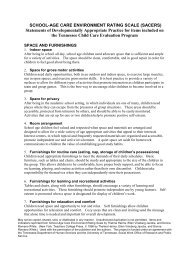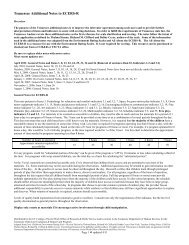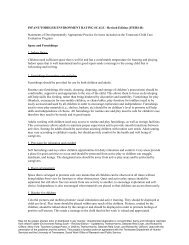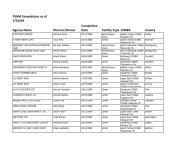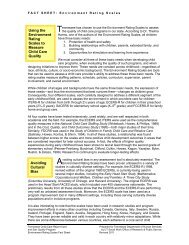Tennessee Additional Notes to SACERS Page 1 Updated 7/10
Tennessee Additional Notes to SACERS Page 1 Updated 7/10
Tennessee Additional Notes to SACERS Page 1 Updated 7/10
- No tags were found...
Create successful ePaper yourself
Turn your PDF publications into a flip-book with our unique Google optimized e-Paper software.
<strong>Tennessee</strong> <strong>Additional</strong> <strong>Notes</strong> <strong>to</strong> <strong>SACERS</strong>5.2 "Variety" means there must be variety in materials for 2 of the 3 categories (cassettes, dance props, musical instruments).7.1 If every 2 weeks <strong>to</strong> monthly, score 6.22. Blocks and construction3.2 This indica<strong>to</strong>r means “appropriate” in the most basic sense. If children seem <strong>to</strong> be able <strong>to</strong> use materials well, without majorinconveniences, give credit <strong>to</strong> this indica<strong>to</strong>r. For example, if blocks are being used, there should be a level, firm surface, and not <strong>to</strong>o manydisruptions.5.1 Delete the word “some” from this indica<strong>to</strong>r.23. Drama/ theater* Materials: dress-up clothes, costumes, props, puppets, action figures, dolls (both adult and baby).Drama is more organized than pretend. There is no difference in the type of prop, only n the degree of pretend or dramatic play. (TN 7/20/01)3.1 Change “and” <strong>to</strong> “/” so indica<strong>to</strong>r now reads, “Some pretend/drama props accessible. “3.2 For this indica<strong>to</strong>r, "support offered by staff" means that staff have made space and materials needed for play accessible <strong>to</strong> the children.Children play without much adult input. When disagreements occur in the play, staff participate in helping <strong>to</strong> solve problems.5.1 The items in parentheses are just examples. Enough props should be accessible for meaningful play <strong>to</strong> support two roles or situations.5.2 To give credit for this indica<strong>to</strong>r, more active involvement is required than that required in 3.2. Staff add <strong>to</strong> the children's possibilities fordramatic play. For example, if the drama is very active, staff might provide children with a larger space. Or if children need more props, staffmight help them find what they need. Must observe at least one incidence.7.1 Add “and” so indica<strong>to</strong>r reads, “Pictures, s<strong>to</strong>ries, and trips . . .” Outside trips are not required for this indica<strong>to</strong>r. Credit can be given forbringing community resources in<strong>to</strong> the program.24. Language/reading activities3.2 Credit can be given when this is done by either staff or older children, who are fluent in reading or telling a s<strong>to</strong>ry.5.1 The age of the children in the group is a key fac<strong>to</strong>r in deciding appropriateness. Younger children (k-2) who still may not be able <strong>to</strong>separate fantasy and reality should not have access <strong>to</strong> inappropriate books or games. Appropriateness includes content that is not graphicallyviolent or sexually explicit. For older children, the vast majority of materials should be appropriate, with no materials being extremelyinappropriate. Since children will probably not lack exposure <strong>to</strong> inappropriate materials in other settings, the school age program shouldconcentrate on positive input. Provision of books and games on different reading levels is also part of appropriateness. (TN 3/13/02)5.2 Must observe at least one instance during the observation.5.3 Must observe more than one example.25. Math/ reasoning activities3.1 Replace “and” with “/” so the indica<strong>to</strong>r reads, “Some age-appropriate math/reasoning games/activities accessible . . .”5.1 Replace the phrase “games and activities” with “games and/or activities”. If there are 3-5 games that are accessible, give credit for thisindica<strong>to</strong>r.5.2 The intent of this indica<strong>to</strong>r is for adults <strong>to</strong> link math and numbers <strong>to</strong> practical life events in the children’s daily schedule. Therefore, lookfor use of numbers during meals or when fixing own snacks, setting the table for correct number of children, transition times, using a timer <strong>to</strong>take turns, keeping scores in ball games, taking attendance by children, talking about times <strong>to</strong> do things and looking at the clock,arriving/leaving, etc. Do not count play activities such as number games, computer games, or homework in determining the score for thisindica<strong>to</strong>r. “Number talk” or number experiences as part of practical life events should be observed more than once during the observation <strong>to</strong>give credit for this indica<strong>to</strong>r.Distributed by the UT College of Social Work Office of Research & Public Service under contract <strong>to</strong> the <strong>Tennessee</strong> Department of Human Services for the<strong>Tennessee</strong> Child Care Evaluation & Report Card Program.Adapted from School-Age Care Rating Scale, by Thelma Harms, Ellen Vineberg Jacobs, and Donna Romano White. (New York: Teachers College Press, ©1996by Thelma Harms, Ellen Vineberg Jacobs, and Donna Romano White.) Used with permission of the publisher and the authors. All rights reserved. This project isfunded under an agreement with the <strong>Tennessee</strong> Department of Human Services and the University of <strong>Tennessee</strong>, Social Work Office ofResearch and Policy Services.<strong>Page</strong> 6 <strong>Updated</strong> 7/<strong>10</strong>




